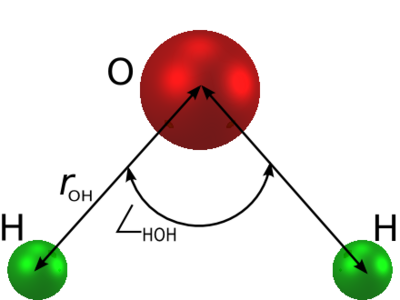SPC/HW model of water: Difference between revisions
Jump to navigation
Jump to search
m (Updated figure) |
Carl McBride (talk | contribs) m (Added a recent publication) |
||
| (One intermediate revision by one other user not shown) | |||
| Line 1: | Line 1: | ||
The '''SPC/HW''' model is an [[SPC]] model designed for heavy [[water]]. The molecule is modelled as | The '''SPC/HW''' model is an [[SPC]] model designed for heavy [[water]]. The molecule is modelled as | ||
a rigid isosceles triangle, having charges situated on each of the three atoms. Apart from Coulombic interactions, the molecules interact via long-range [[Lennard-Jones model | Lennard-Jones]] sites, situated on the oxygen atoms, i.e. ( | a rigid isosceles triangle, having charges situated on each of the three atoms. Apart from Coulombic interactions, the molecules interact via long-range [[Lennard-Jones model | Lennard-Jones]] sites, situated on the oxygen atoms, i.e. (Eq. 1 in <ref>[http://dx.doi.org/10.1063/1.1359183 J. Raul Grigera "An effective pair potential for heavy water", Journal of Chemical Physics '''114''' pp. 8064-8067 (2001)]</ref>): | ||
:<math>\Phi_{i,j}= \left[ \frac{C_{12}}{r_{OO}(i,j)}\right]^{12} - \left[ \frac{C_{6}}{r_{OO}(i,j)}\right]^{6} + \sum_{\alpha=1}^3 \sum_{\beta=1}^3 \frac{q_\alpha(i) q_\beta(j)}{r_{\alpha \beta}(i,j)}</math> | :<math>\Phi_{i,j}= \left[ \frac{C_{12}}{r_{OO}(i,j)}\right]^{12} - \left[ \frac{C_{6}}{r_{OO}(i,j)}\right]^{6} + \sum_{\alpha=1}^3 \sum_{\beta=1}^3 \frac{q_\alpha(i) q_\beta(j)}{r_{\alpha \beta}(i,j)}</math> | ||
| Line 14: | Line 14: | ||
| <math>C_6</math> || <math> 0.3712 </math> (kJ mol<sup>-1</sup>) <sup>1/6</sup>nm | | <math>C_6</math> || <math> 0.3712 </math> (kJ mol<sup>-1</sup>) <sup>1/6</sup>nm | ||
|- | |- | ||
| <math>r_\mathrm{OH}</math> || <math>1.000 | | <math>r_\mathrm{OH}</math> || <math>1.000</math> Å | ||
|- | |- | ||
| <math>\angle_\mathrm{HOH}</math> || <math>109.47^{\circ}</math> | | <math>\angle_\mathrm{HOH}</math> || <math>109.47^{\circ}</math> | ||
| Line 24: | Line 24: | ||
==References== | ==References== | ||
<references/> | |||
;Related reading | |||
*[http://dx.doi.org/10.1021/je300064f Dibyendu Bandyopadhyay, Sadhana Mohan, Swapan K. Ghosh, and Niharendu Choudhury "Properties of Heavy Water in the Temperature Range T = 223 K to 373 K from Molecular Dynamics Simulation Using the Simple Point Charge/Heavy Water (SPC/HW) Model", Journal of Chemical and Engineering Data '''57''' pp. 1751-1758 (2012)] | |||
[[category: water]] | [[category: water]] | ||
[[category: models]] | [[category: models]] | ||
Latest revision as of 15:07, 12 July 2012
The SPC/HW model is an SPC model designed for heavy water. The molecule is modelled as a rigid isosceles triangle, having charges situated on each of the three atoms. Apart from Coulombic interactions, the molecules interact via long-range Lennard-Jones sites, situated on the oxygen atoms, i.e. (Eq. 1 in [1]):
The parameters are as follows (Ref 1 Table I. Note, in the table the HOH (DOD) angle is given as 109.43 but in the text as 109.47):

| parameter | value |
| (kJ mol-1) 1/12nm | |
| (kJ mol-1) 1/6nm | |
| Å | |
| (charge neutrality) |
References[edit]
- Related reading
![{\displaystyle \Phi _{i,j}=\left[{\frac {C_{12}}{r_{OO}(i,j)}}\right]^{12}-\left[{\frac {C_{6}}{r_{OO}(i,j)}}\right]^{6}+\sum _{\alpha =1}^{3}\sum _{\beta =1}^{3}{\frac {q_{\alpha }(i)q_{\beta }(j)}{r_{\alpha \beta }(i,j)}}}](https://wikimedia.org/api/rest_v1/media/math/render/svg/2af31454c05c097fda54f375e6fc30bfae52ca0c)











